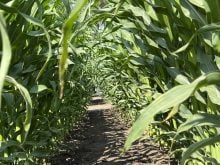SASKATOON — Grain and oilseed farmers should not expect any price help from South America, say analysts.
That region of the world is anticipating another bumper crop of corn and soybeans.
“It’s hard to imagine any major shifts that would change the outlook for a record South American harvest,” Joana Colussi, an agricultural economist with the University of Illinois, said during the university’s recent farmdoc webinar.
Read Also

Fertilizer method’s link to emissions studied
A researcher says others studying greenhouse gas emissions aren’t considering how the loss of nitrogen into the atmosphere correlates with fertilizer application or if there is an impact to yield.
The region is set to harvest 8.42 billion bushels of soybeans over the next few months.
“It’s likely to keep global prices under pressure at least (through) the first half of the year,” she said.
Conab is forecasting Brazil will harvest a record 6.15 billion bushels of the oilseed, a 13 perc ent increase over the previous year.
An estimated 61 per cent of the crop was already in the bin as of March 9.
Yield reductions in the south of the country were offset by phenomenal yields in the centre-west portion of Brazil.
Exports are predicted to soar due in part to China’s recently announced 10 per cent tariff on U.S. soybeans.
“This could have big implications for global trade,” said Colussi.
The Brazilian Association of Vegetable Oil Industries is forecasting that Brazil’s soybean exports could reach 3.9 billion bu. in 2025, a seven percent increase over last year.
Soybean export premiums in Brazilian ports have reached their highest level since 2022. The premium at the Paranagua port in southern Brazil is US$0.85 per bushel for March 2025 shipment.
Colussi said the depreciation of the Brazilian real versus the U.S. dollar has helped sales, and that competitive advantage is expected to remain in place in 2025.
Crop prospects in Argentina looked grim after a dry January, but a long-awaited rainfall arrived in late February.
“The situation completely changed,” said Silvina Cabrini, analyst with the National Institute of Agricultural Technology.
Soybean planting increased by eight per cent to 44 million acres, with 92 per cent of first season soybeans and 76 per cent of the second season crop in good condition.
The Buenos Aires Grain Exchange is forecasting 1.82 billion bu. of production for the 2024-25 crop, up from 1.77 billion bu. the previous year.
Argentina primarily exports soybean meal and oil. Exports taxes on seed were dropped to 26 per cent in January from 33 per cent. That reduction will remain in place until the end of June 2025.
An estimated 83 per cent of Brazil’s safrinha, or second, corn crop was planted as of March 9.
Planting was slightly delayed due to excessive rainfall in the country’s centre-west.
Weather in March and April will be critical in determining the final size of the crop.
Conab is forecasting 4.83 billion bu. of total corn production in 2024-25, a six per cent increase.
Brazil’s corn exports exploded in 2023 to 2.2 billion bu. after China allowed imports from the country. Brazil displaced the U.S. as the world’s top exporter that year.
However, sales fell in 2024 to 1.56 billion bu. as supplies recovered in the U.S., the European Union and Argentina.
China reduced imports from all suppliers that year due to vastly improved domestic production and waning demand from its livestock sector.
Fortunately, Brazil is experiencing a boom in domestic corn ethanol demand.
There are now 21 ethanol plants using corn as a feedstock. The country produced 6.27 billion litres of corn ethanol in 2023-24, up from 80 million litres 10 years ago.
“Corn ethanol production in Brazil is growing fast and it’s possible to double in just two or three years,” said Colussi.
That would generate an additional 1.06 billion litres of domestic corn demand.
The Buenos Aires Grain Exchange is forecasting 1.93 billion bu. of corn production in Argentina in 2024-25, a 15 per cent decline from the previous year.
Farmers in that country slashed acreage due to a severe outbreak of corn stunt disease in 2023-24.
Sales of the crop could be assisted by a drop in export taxes to 9.5 per cent from 12 per cent.
Cabrini said Argentina’s lower export taxes and a stable economy could boost investment, technology adoption, productivity and agricultural exports in the coming years.
Colussi said there are some projections that Brazil’s corn production could increase by 30 per cent and its soybean production by 20 to 25 percent over the next decade.
There is potential to convert 70 million acres of pasture in the northeast and parts of the centre-west into cropland.
Another 40 million acres could be added to corn production by increasing the amount of double cropping that occurs in Brazil.


















